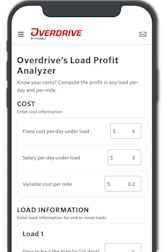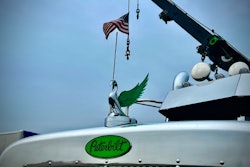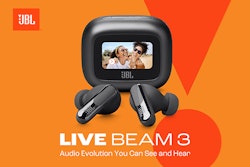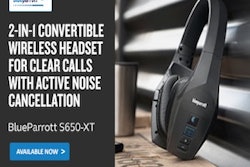Regular Overdrive readers by now well know 2024 Trucker of the Year Alan Kitzhaber. His 4M-plus-mile 1995 Kenworth T600 got plenty ink for a whole host of reasons, not least of which the many mods he made to it through the years with efficiency in mind. Oh, and those miles -- all of them were logged under his tutelage, since he first hopped in the truck as a company driver when it was new, later purchasing it from Millis Transfer before a long career with authority.
He sold the truck this past Spring after officially retiring from the road. Yet before he said goodbye to the rig officially, he took the time to detail a less-talked-about aspect of his life and work in and around the T600. With the rig cleaned up and cleaned out for sale, he had one last task -- to walk you through a seven-exercise in-cab workout the owner-operator undertook several years back in line with well-known fitness coach Steve Maxwell's "Seven Pillars of Human Movement" notion. That is, seven exercises any trucker can do regularly in-cab to work evey part of the body that matters for long-term maintenance.
[Related: For sale by owner-operator: Notes on the big unload at retirement]
The results of Kitzhaber's effort you'll find in the video up top, and you can access some of his motivations for undertaking it years back via this story he wrote early in the year. In the video, he offers different options and ways to work yourself up to more reps and different options for some of the seven exercises, which he outlined as satisfying these seven pillars, to use Maxwell's terminology:
- Vertical push = overhead press, pike push-up
- Vertical pull = pull-ups
- Horizontal push = bench press, push-up
- Horizontal pull = Australian push-up or inverted row
- Hinge = dead lift
- Squat = Squat
- Core = sit-ups or crunches

Bookmark this page and come back when you're ready or as often as you may need. Near the beginning of the video, Kitzhaber walks through simple equipment you'll need and just a couple cab mods he made to be able to do the full workout in the confines of his T600's sleeper.
As he told me when we talked back early in the year for this Overdrive Radio podcast episode announcing his big win as Trucker of the Year, his goal was "functional fitness," essentially keeping his body in shape to enjoy the basics of life and work, minus the aches and pains that were beginning to set in.
In his late 50s, like so many other truckers, he "was having a lot of problems with the pains in my shoulders," he said. "When you reach your arm up -- it was just not comfortable." Likewise "pain between my shoulder blades," a "common complaint that I hear from a lot of truck drivers" after years with arms forward on the steering wheel.
These exercises would eventually solve those issues, with his own persistence in performing them. No more aches, pains and the like.
He advises others looking to incorporate something like this not to think about re-inventing the wheel overnight, or training for a marathon, as it were. Rather, as he told me early this year, it's been typical for him to run through the seven-exercise routine just "twice a week. It's all that's necessary. And it takes about 20 minutes. ...
"I just wanted to do enough that I could strengthen my muscles in all areas of my body to the point it was going to benefit me."
And it has. Follow along with him in the video at the top.
 Nominate your own or another deserving owner-operator business for the 2025 Trucker of the Year award via this link. Entries are open through next month. Sponsored by Commercial Vehicle Group and Bostrom Seating, the competition recognizes business acumen and unique or time-honored recipes for success among owner-operators.
Nominate your own or another deserving owner-operator business for the 2025 Trucker of the Year award via this link. Entries are open through next month. Sponsored by Commercial Vehicle Group and Bostrom Seating, the competition recognizes business acumen and unique or time-honored recipes for success among owner-operators.
[Related: Take care of yourself with diet, exercise: You'll be better able to enjoy the fruits of your labor]
Find more insight on the road to fitness over the long haul in the Overdrive/ATBS coproduction of the Partners in Business playbook, which offers health and financial strategies toward a comfortable retirement in the Finish Line section. PIB is a comprehensive trucking guide, a resource for owner-operators for well more than 20 years. The new guide offers insights into starting, growing, and (ultimately) finishing a trucking business. Now available in a mobile-friendly format, it covers everything from business planning to retirement strategies.
In this video:
00:00 – Workout Routine Inspiration
01:49 – Preparation
03:11 – Overhead Press Option 1
04:12 – Overhead Press Option 2
05:06 - Overhead Press Option 3
06:38 – Assisted Pull-Up
07:50 – Push-Up
08:52 – Inverted Row
09:58 – Core
11:18 – Hinge
14:16 – Squat
15:15 – Final Thoughts
Alan Kitzhaber: Good morning, fellow truck drivers. This is Alan Kitzhaber. I am the Overdrive magazine, 2024 Truck Driver of the year. One of the things we talked about in January, when I was announced as the winner for 2024, was, exercise program that I have. And, I thought maybe I would do a video on it to help explain it a little bit better.
This started probably when I was about 60. I'm 66 right now. When I got to be about 60, I was having a lot of problems with the pains in my shoulders. You know, when you reach your arm up, it was just not comfortable. Pain between my shoulder blades. You know, you got that steering wheel in your hands all the time, and it just,
It's a common complaint that I hear from a lot of truck drivers. So then I finally found a guy named Steve Maxwell. He was involved in jujitsu for many, many years. He owned a gym at one time. He's traveled the world teaching physical fitness. And the thing that he promotes just for general physical fitness, he uses something called the Five Pillars of Human Movement.
That's what he focuses on, which amounts to seven exercises. The overhead press, the overhead pull, which would be a pull up, then vertical push, and then the vertical pull, which would be a inverted push up or Australian push up. The next would be the core, then the hinge, which would be like a deadlift, and then the squat, which is kind of self-explanatory.
And so what I want to do is go through all those seven exercises showing you what I do, and talk about each one just a little bit. It certainly has worked well for me. I don't have those shoulder pains. I don't have the pains between my shoulder blades anymore. That's all gone. So it is working. Now, what I've got here is a in the back.
You can see that plywood back there. That is a 72 inch long by 26 inch wide piece of three quarter inch plywood that I cut out, and I use poly polyurethane finish to cover it just to make it smooth and keep it clean and so forth. And I just tuck it in between the mattress and the back of the sleeper.
And I'm going to pull that out right now.
And the reason I did this is because the mattress is just way too soft. You can't do push ups and sit ups and other exercises very well when you're sinking into the bed. So the purpose of this is to flatten things out and stores very easily. Then on top of that, I put a yoga mat and, the pull up bar is actually made out of an old load lock.
Just cut it off and hung it up there. It's a little bigger than the pull up bar you'd find at the gym. But it's lightweight. And that's. That appealed to me. Okay, this is the bracket that I made to, rest that, load locking in, and you can see there's a nail right there that I drilled a hole in it so it wouldn't spin.
And then I have screws that came up from the bottom to hold it in place. Just made out of two by sixes. I believe the, overhead press has a couple of options. I'm going to do what is called a pike push up as best I can. And you're going to notice when I do it that I can't straighten my legs out completely.
And that's, I think, a function of, probably just age. When I get set up to do this, I keep my feet about shoulder width apart, maybe a little bit further, and I put my hands down right in front of my knees. And I do this. So they kind of measure from up to the tip of my finger.
And then I move my hand forward to that point. And I do that so that I have the same hand placement each time I do the exercise. So there's a little more consistency.
This is an option for people who aren't able to. I wasn't able to do what I just did when I first started out. And this is a way to work your way up to it, and you got to go for it. Handles. They snap in place. The tube and what I'm going to do is lay the tube down on the floor and stand on it.
And the nice thing about these tubes is they come in different resistances. So you can start out very easy, very light, and then work your way up as time goes on. And so I'll stand on these.
Another option that you can do is for you guys that are in the household moving business. You know what a forearm forklift is? This is it rolled up. And what it's used for is moving furniture. And it has within the strap. There's loops here. Another loop here, another loop here. That way you can have it's adjustable. And they found that for people who are on the go for physical fitness, these work really, really well.
For an overhead press, you start the exercise and you exert yourself at 50% for 30s. Then you exert yourself at 80% for the next 30s and then for the next 30s you do it as hard as you can or hard as you dare. You don't want to go as hard as you can or injure yourself so short of injuring yourself.
That's about the amount of, force that you want to exert when doing that particular exercise, because you'd find about the halfway point in that motion, and that is where you would want to have your strap taut, and then you push in that direction for 30s and then another 30 and then another 30 until you get to the 90s.
And that's it. And they are quite effective. The forearm forklift is maybe a little too short to stand on for most people, so kneeling on it would be necessary. The other option is a two inch ratchet strap. Length probably wouldn't be an issue, because most of those are 20ft long, and it probably is something you already have next to be doing the pull up.
I can't do very many things like one or maybe two of them on a good day. So then that's where the tubes and the D handle come in handy. I stick my foot in this one.
Stick my foot in this one. And for people getting started out with the pull ups, this is a good way to do it. Do it assisted until you get strong arms to the other side.
Another thing you can do. When you're just getting started with pull ups, which is going to be one of the more difficult exercises, is by far what you can do to help yourself build up your strength is do an eccentric motion movement on the pull ups, and that would be to get yourself all the way up as high as you can, and then slowly let yourself down as slowly as you can.
Well, I hope you get the idea on how that works. Oftentimes you see people doing push ups and it's they'll push up and they'll go to here, they'll have their hands out wide and go just up like this. Very, very limited range of motion. That's better than nothing, I grant that, but the full range of motion means that you do a push up, you bring yourself down, your chest is touching, and that or the floor.
And then another full extension out. If you can do 20 push ups the other way, the first way I showed you probably only be able to do about 8 or 10 full range motion ones when I'm doing a push up, instead of having my hands out like this, I have my hands in close. It's actually better for your joints.
It builds more strength and they are harder to do.
When doing the inverted roll or Australian push up, I started out initially I would just go back at an angle and pull myself forward. So I do it in this direction, but it's hard to see. So you let yourself back and pull yourself forward and then just increase that angle as your strength improves. And I did that until I got to the point where I can do this exercise.
As I'm going to demonstrate now.
That really, really helps between the back to between the shoulder blades as we're driving, we got our arms out here like this, and we're stretching those muscles back there, and we've kind of hunched over a little bit in a lot of cases, and that really helps to strengthen those muscles there. So between doing the overhead press and the inverted push up, those are the two exercises I think probably benefited me the most for the aches and pains and such that I was experiencing.
And there are a variety of ways of doing it. Just simple set ups that I have here is a strap that I'm going to strap around the board that I can stick my feet under. When it comes to sit ups, there's or crunches. There's all different options. The one that I like to use is I hold my feet under that strap, and then I go from laying down position to maybe about 45 degrees and then back down and up again.
The advantage of doing it this way is that you stay under tension the whole time, and that is another big part of increasing your strength, is the amount of time that your muscles are under tension during that exercise. And the other thing is when people do push or sit ups and they go from the horizontal position all the way up, if you notice, you'll feel that vertebrae right there on your pelvis.
It kind of rocks back and forth, and it's really not good for it. Tips over in that point. And so this avoids that. And plus it keeps you under tension the entire time which you get more out of. So I'll show you how I do it.
Now I'm going to move the strap forward and do the hinge. So what I'm going to do on this exercise is stick my feet underneath the strap, where my ankles will be underneath of it, and I'm going to lean forward and then backward. And I'm going to be focusing on my lower back. This is where this is what the deadlift really addresses is your lower back and your posterior muscle chain as a whole.
And I'm going to move very slowly this way, and then back and this way, and then back and I'll focus on contracting those lower muscle or the lower back muscles when I do this. And I'll do this probably about 30 reps and, one thing that does happen to me, I don't know if it will tell you or not, but your hamstrings or my hamstrings will tighten up on me.
And you'll probably see when I do this that, I'll just lean back, squat and that seems to that corrects it. And after the first, say 3 or 4 reps, it doesn't tighten up on me anymore. So I don't know if that's just me or if that's something other people will experience. But if you do experience that, you'll know how to deal with it.
This strap has a little buckle on it so I can adjust the tightness of it, so anything that you can find that would accomplish the same task will certainly be good. So now I just I try and have it have a straight back as much as I can and then just lean forward. And back. And I start out slow.
I don't get too carried away because I don't want to pull muscle.
Now my take. My hamstrings are tightening up on me a little bit. I just squat down like this and then go back. It seems to take care of the problem.
Here's an example of where the forearm forklift can come in handy for doing a hinge. Here you can stand on the strap or what you can't see real well from where you're at. Unfortunately, I'm a little restricted as far as camera angle options inside the truck, but here it is on either side of me and you just reach down, grab on to that strap at that point, that midpoint, and then you pull up on it, do your 30s at 50, 30s at 80, and then as much as you dare and you'll be surprised at, what it does to your muscles.
These are effective exercises. And for some people, this is all they do. All you need is a strap. Doing any kind of squat is better than nothing, but having a full range of motion is going to be best. In other words, getting your rear end down as low as it can go. And as you go down, try and keep your back straight as you can.
And that means I lean back to the point where I'm almost going to fall over backwards. It's a lot more difficult that way than just leaning forward and doing that. But when you're just getting started, that may be all you can do. And if you want to add weight or with a weight vest or something like that, you can.
And one of the advantages of all these exercises that I'm doing is it doesn't take a lot in the way of materials or weight. Hopefully you can see, but I'm going to start. Usually I do about 10 to 15 of these and then that's about it. But here we go.
Well I hope all of this helps inspire you guys to maybe start some kind of a exercise program of your own. The big thing is do something, otherwise your body will suffer. This is what I did, and it's worked for me. And certainly a lot better condition that otherwise would be. So, I hope you guys enjoyed this.
And, if you have any questions, comments or concerns, just, leave a note in the comments and, I'll try to get back to you as soon as I can.











